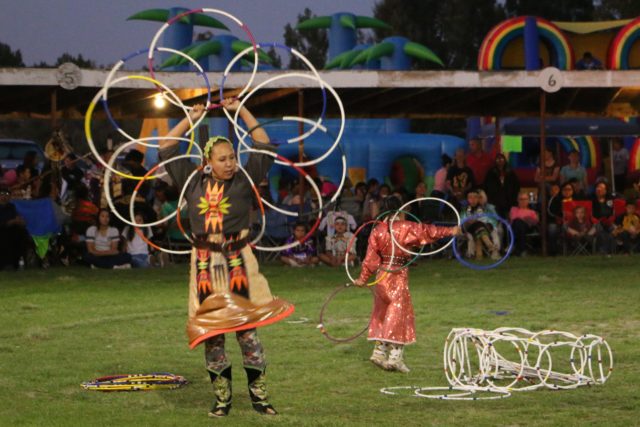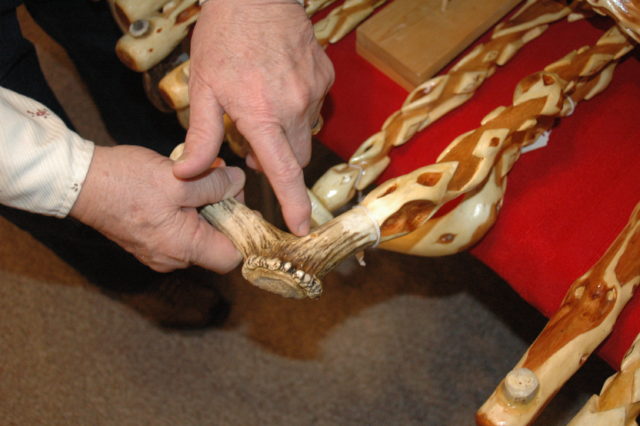Folk and Traditional Arts
The goal of the Folk & Traditional Arts Program is to identify, document, conserve, and honor folk & traditional arts throughout Wyoming.
Jim Jackson, a master of the Sheridan style leather carving tradition, received both the National Heritage Fellowship and the Wyoming Governor’s Art Award in 2019.
What are Folk and Traditional Arts?
Folk and Traditional Arts are grassroots, community-based, creative expressions of cultural identity. They are shaped out of common experiences, being rooted in communities such as family, religion, tribes, ethnicities, or regional, occupational, and recreational groups. Folk Arts remind us of who we are, where we came from, and where we are going. They are typically learned and practiced informally, and are deeply embedded in communities. Folk arts also generally hold some level of special significance to the community from which they come. As such, they are simultaneously highly reflective of community values, while also constantly evolving to meet their community’s needs. Folk arts are about the social side of art–they are all about context and process, rather than content and product.
In Wyoming, some of the more common traditional art forms are saddlemaking and leatherwork, cowboy poetry, beading and quill work, quilting, rawhide braiding, powwow songs and dances, German-Russian Dutch Hop, Mexican ballet folklorico, wood carving, rug braiding, fly tying, taxidermy, and more.

Jasmine Pickner-Bell, world champion hoop dancer, performing at the 2019 Northern Arapaho Powwow in Arapahoe, Wyoming.
How do we support Folk & Traditional Arts?
Supporting the folk & traditional arts in Wyoming is included as part of our strategic plan.
Some of the key ways we do this are:
- Award Folk & Traditional Art Mentoring grants to master tradition bearers who want to pass on their creative tradition. See Mentoring Project Grants.
- Encourage organizations to apply for a Community Support Grant for organizations to include appropriate folk art and artists in their programming, including:identifying and documenting contemporary folk art and tradition bearers, celebrating cultural heritage or share local traditional arts, or bringing traditions from around the world to Wyoming.
- Find ways to honor and foster public awareness and appreciation of Wyoming’s traditional arts and artists through publications, documentary films, exhibits and lectures.
- Encourage Wyoming organizations to apply for larger federal grants to support folk & traditional artists in our communities, such as the National Endowment for the Arts Grants for Arts Projects, Folk & Traditional arts grant.
What happens to the fieldwork/documentation we do?
Ultimately, it becomes part of the Wyoming Folklife Collection. The Wyoming Folklife Collection consists of fieldwork documentation and administrative files from the Folklife Program of the University of Wyoming American Studies Program and the Folk & Traditional Arts Program of the Wyoming Arts Council. Both programs began in the 1980s and then were dormant from the mid-1990s until being revived in mid-2000s. The collection is stored at the American Heritage Center at UW; the collection description can be seen here. .
National Heritage Fellowships
National Heritage Fellowships are the nation’s highest honor in the folk & traditional arts. These fellowships recognize artistic excellence, lifetime achievement, and contributions to our nation’s traditional arts heritage. Wyoming has had four traditional artists receive the honor:
Don King, western saddlemaking, 1991
Eva McAdams, Shoshone regalia, 1996
Martin Goicoechea, Basque (Bertsolari) poetry, 2003
James Jackson, Sheridan style leatherwork, 2019
For information on how to nominate somebody for a National Heritage Fellowship, visit the National Endowment for the Arts National Heritage Fellowship webpage.
Want to learn more about folk & traditional arts?
To learn more about folklore, folk art, and folklife, visit the Library of Congress American Folklife Center to read “American Folklife: A Commonwealth of Cultures” by Mary Hufford.
To learn more about some of the traditional arts found in Wyoming, check out the radio series “…You Know That Wyoming Will Be Your New Home”, originally produced for public radio by the Wyoming Arts Council in 1985.
Additional Resources:
For more information on supporting Folk & Traditional Arts, visit the links below:
- American Folklife Center at the Library of Congress
- National Endowment for the Arts, Folk & Traditional Arts
- American Folklore Society
For more information please contact Josh Chrysler, Folklorist & Health and Wellness Specialist at 307-256-2010 or email joshua.chrysler@wyo.gov.
Contact: Josh Chrysler


